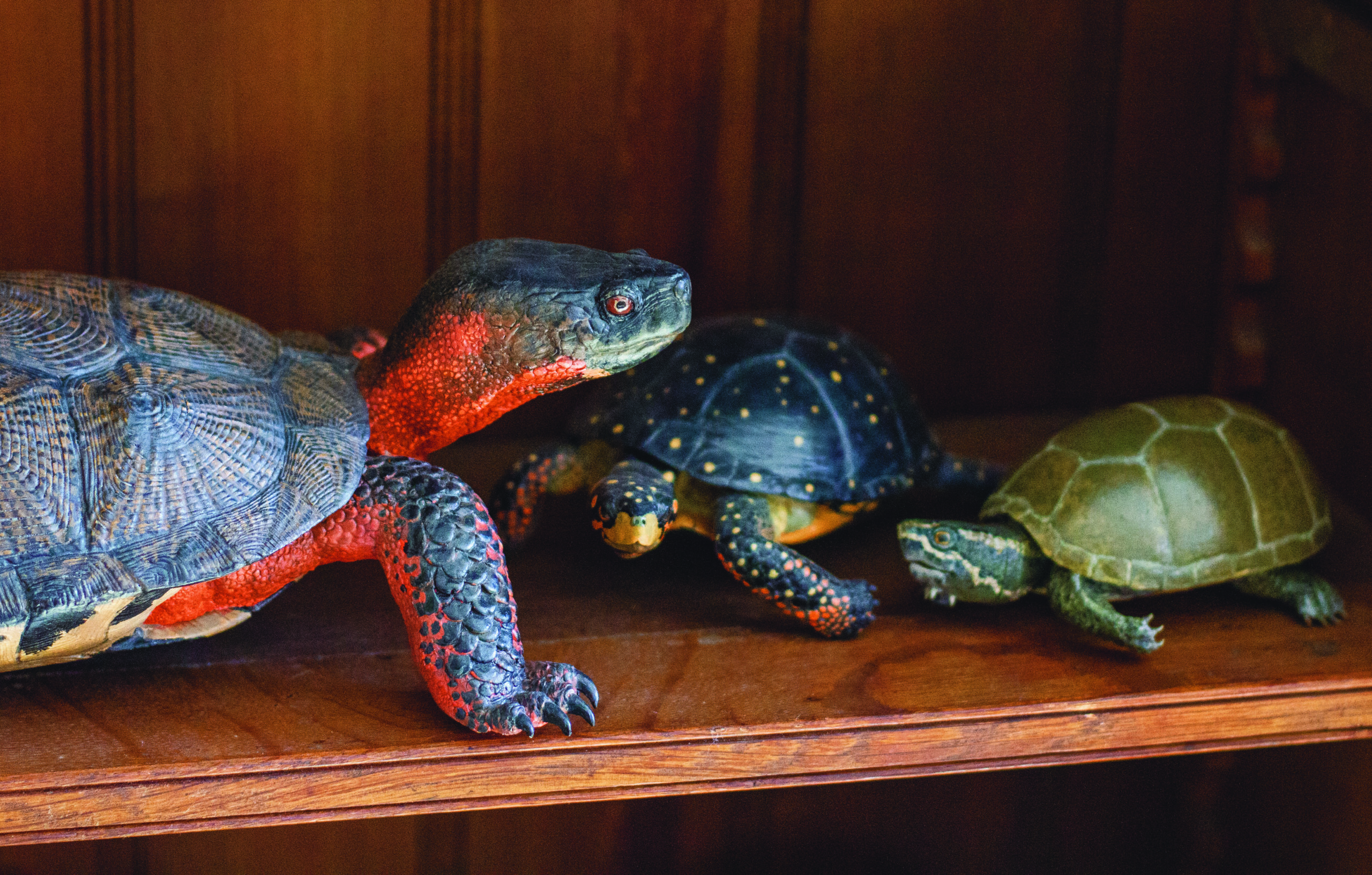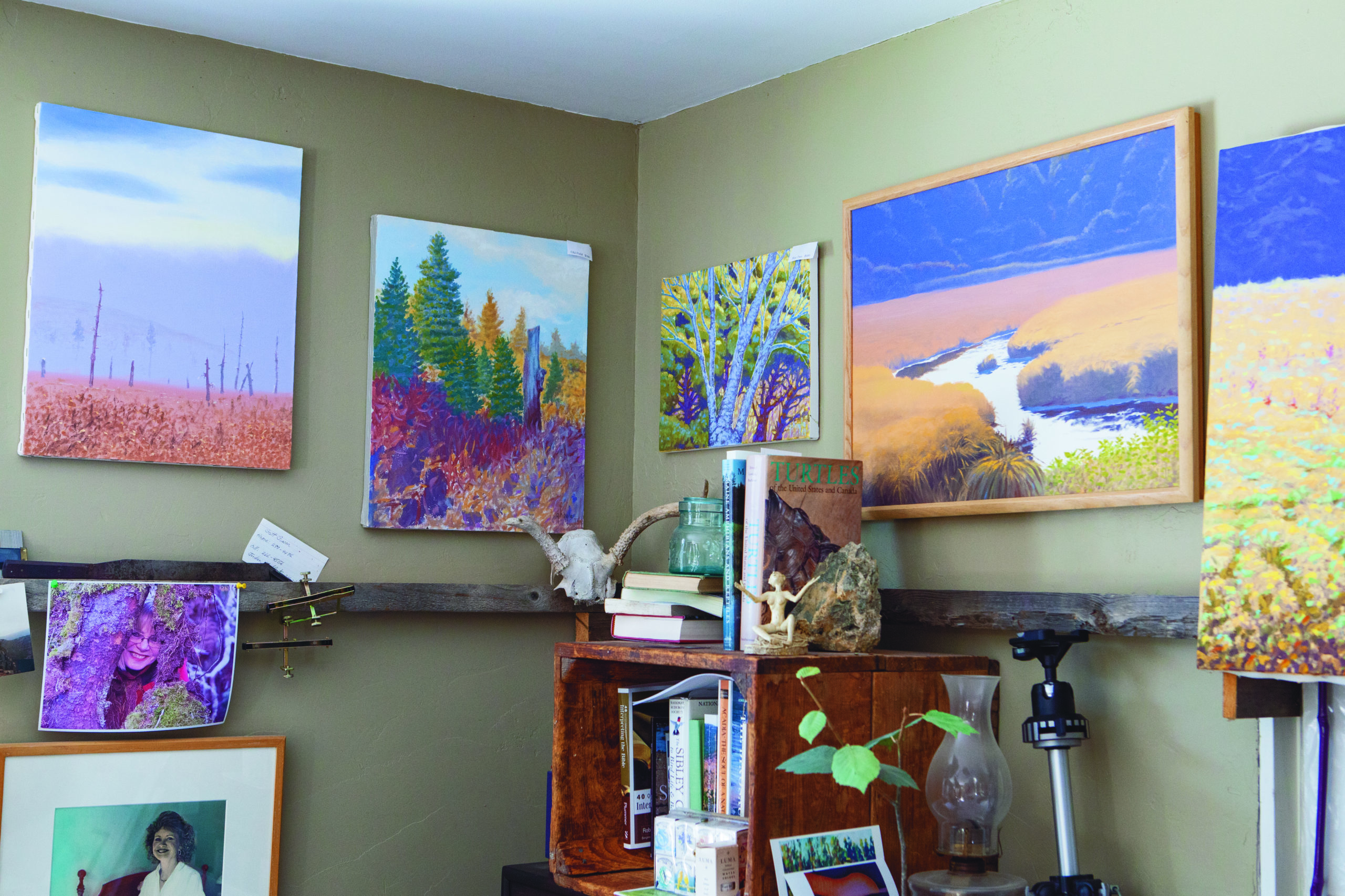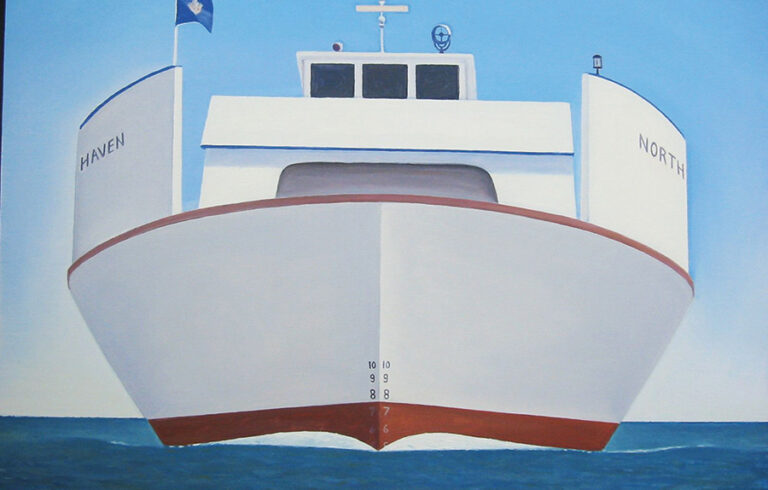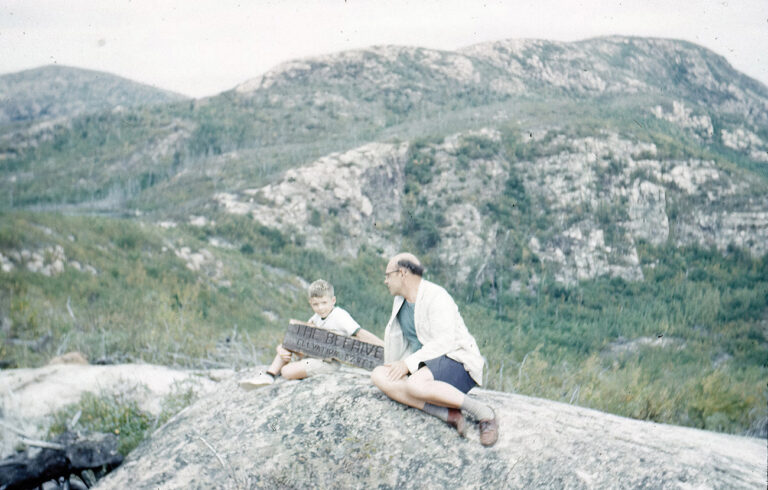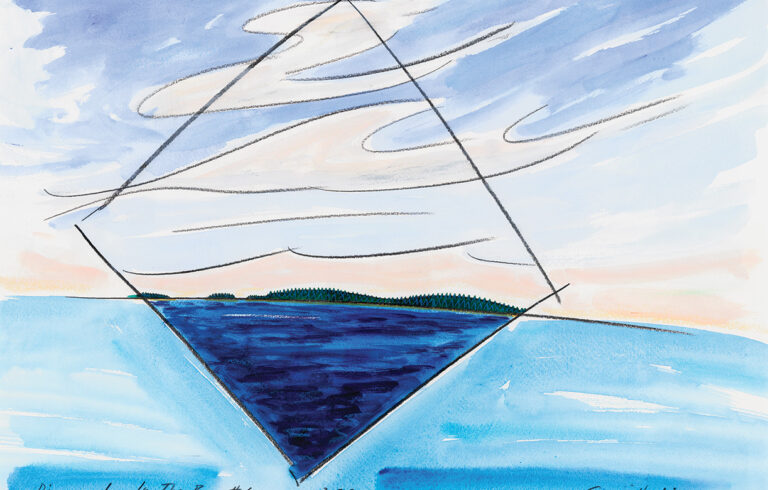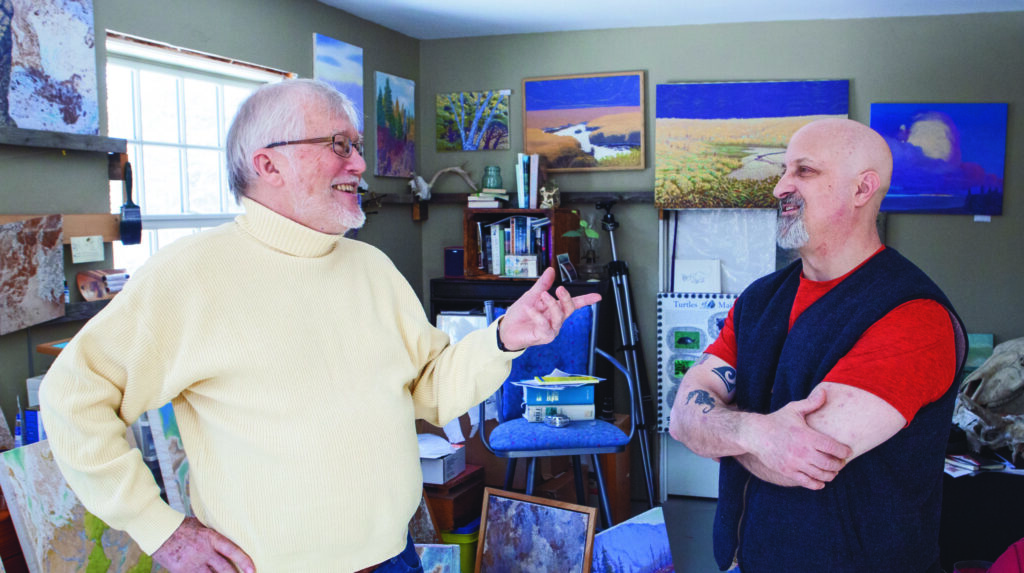
Photos by Jack Sullivan
As I walk off the ferry onto Swan’s Island on a cold February day, I am greeted by the two Garys— Gary Rainford, the poet, whose vanity license plate, POETRY, is a tip-off, and Gary Hoyle, the painter.
We head to Atlantic, one of three villages on the island. On the eastern side, Atlantic looks out on Gott’s Island and Bass Harbor. Rainford refers to it as “the Riviera” of Swan’s Island because in the summertime it can be sunny there and thick-of-fog on the other side of island.
The two men are neighbors and close friends; they talk on a weekly basis about their work.
“And if we’re not communicating about art,” Rainford relates, “we’re borrowing tools and materials.” Hoyle notes that the two share “the same kind of creative impulse” that leads one to words and the other to paint.
We start at Rainford’s home, a cozy, sprawling 200-year-old island Cape that is a work in progress. He has made pumpkin muffins and the hot coffee helps take the edge off the chilly day. The family’s rescue poodle, Barney, barks while Gary’s wife Mimi, a special education teacher in the island school, and his daughter, Meri, prepare for a trip off island.
The Poet
Rainford’s route to Swan’s Island was circuitous. Born in East Meadow, New York, he was bitten by the travel bug while still a teenager. When his mother asked what he wanted for a high school graduation present, he didn’t hesitate: a one-way ticket to Los Angeles.
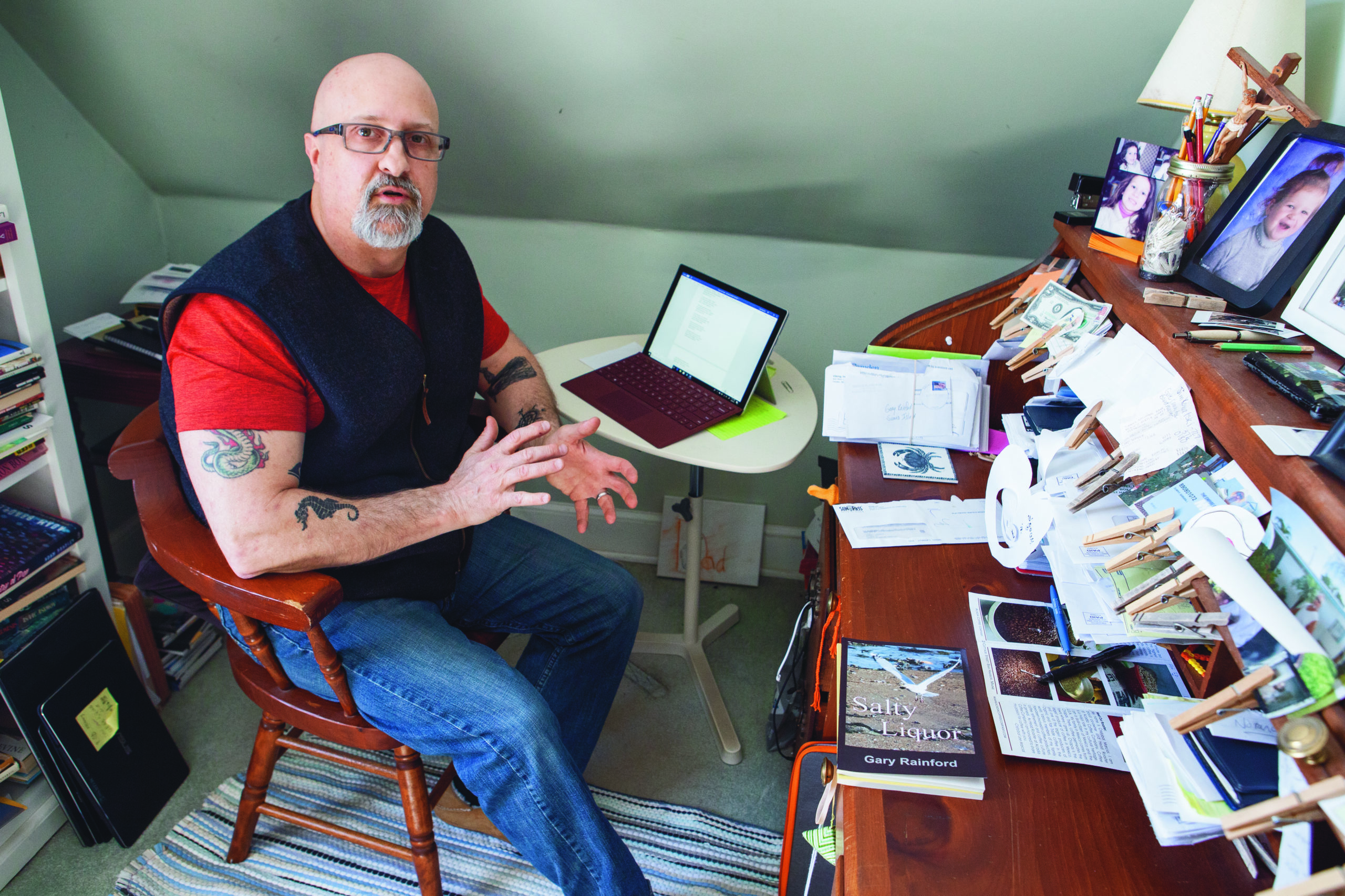
Gary Rainford in his writing nook.
Staying at an aunt’s home in Thousand Oaks, she encouraged him to take a few classes at Long Beach City College. Hooked, he transferred as a junior to the State University of New York at Stony Brook, near his home, and then returned West for grad school at California State University, Sacramento.
On a motorcycle trip up the Oregon coast, Rainford stopped in Bandon on Coos Bay.
“I landed there because it was raining and I knew there was a hostel.” He met his future wife, Mimi Bell, who was from New Hampshire and had family ties to Maine. At some point his mother sent them a copy of Yankee with an article about how Cliff Island in Casco Bay was wooing young people interested in a non-traditional lifestyle and starting a family—“Looking for breeders,” is how Gary puts it. With that seed planted, he and Mimi returned East with the idea of living on an island fixed in their heads.
By then, Rainford had a teaching degree. The couple moved to Rochester, New York, where Gary got a job at Monroe Community College. He still teaches there, via the internet—composition, introduction to literature, and creative writing.
Every chance they had, the pair went to the coast.
They got engaged on Vinalhaven. They arrived on Swan’s in 2001 when Mimi landed a job at the island school. Unable to find long-term housing, they moved to Seal Cove on Mount Desert Island.
Not a week later, Jay Wheaton, a member of the same family from whom Gary and Jeanne Hoyle had bought their land, called to say his mother was ready to sell. The Rainfords felt honored—the community wanted them to stay.
Gary started writing poetry when he was a kid. He recalls “drawing with words in his head” while hospitalized for asthma in sixth grade. Later, in California, he discovered books by punk rocker-turned-poet Henry Rollins and countercultural writer Ken Kesey. He also embraced the writings of Charles Bukowski and Robinson Jeffers, writing his thesis on the latter poet’s philosophy of inhumanism.
Rainford’s first collection of poems, Salty Liquor, (2014), is largely inspired by Swan’s Island and being a stay-at-home dad for his daughter. His second book, Liner Notes, (2017), shifted gears, offering responses to concerts, some he went to and others he found on YouTube. He pays tribute to a wide range of musicians, from Elvis and Ella to Motorhead and Elvis Costello.
“My goal as an artist and poet is to break down whatever it is that makes poetry—including just saying the word ‘poetry’—scary to people, to defuse it and bring more people to the experience,” Rainford says. He is currently working on a new manuscript, Seven Springs, inspired by a year of taking care of his mother as she struggled with onset dementia. Last year he moved her from Florida to a senior living home in Bangor where she now lives.
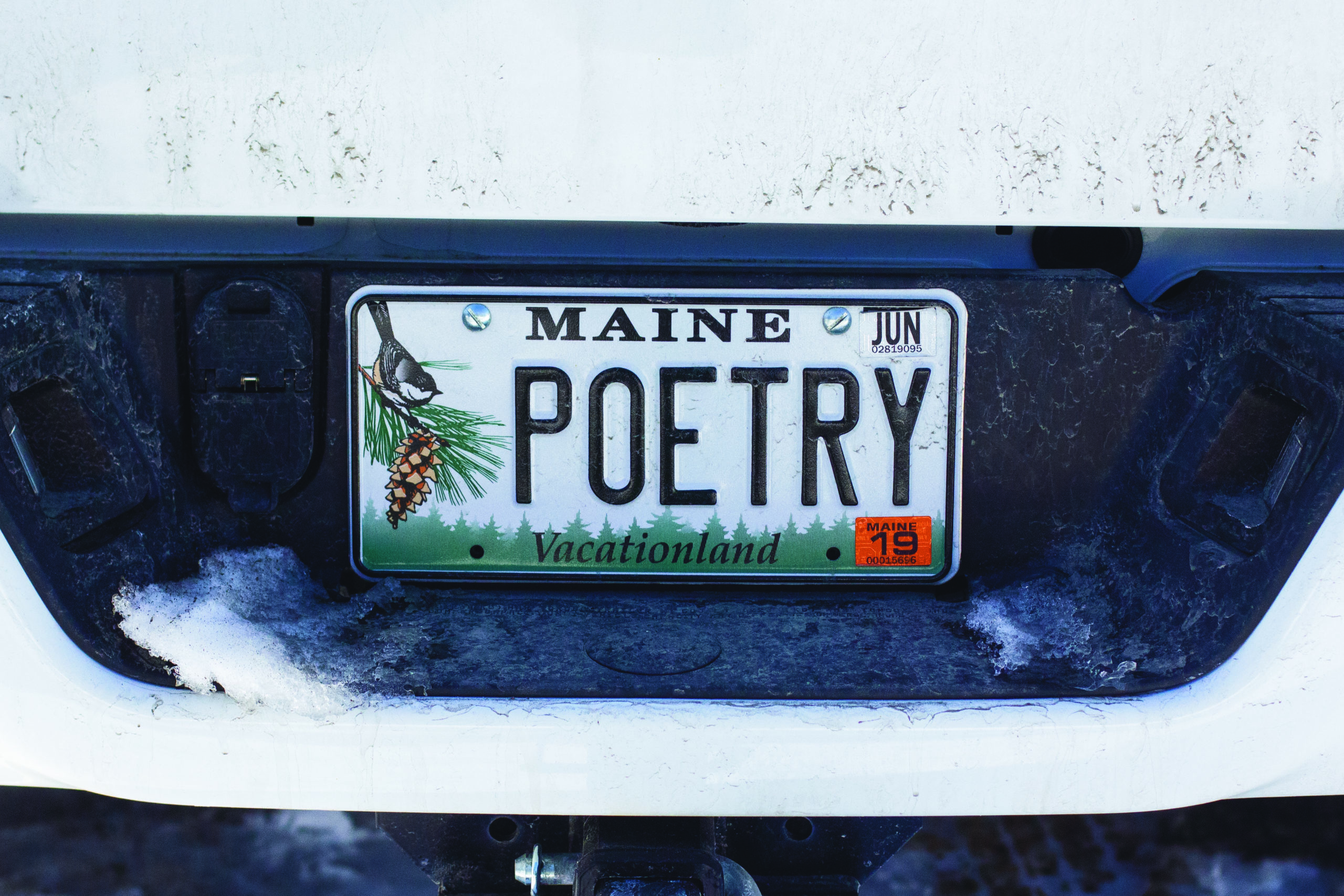
Rainford’s vanity plate
Rainford’s contributions to the cultural life of Swan’s Island range from annual poetry readings to the twice-a-month workshops he leads through Swan’s Island Writes. He has organized a poetry residency with Friends of the Swan’s Island Light, hosting award-winning poet Terese Svoboda in 2018. He also serves as co-editor of The Island Reader, the annual anthology of island writers and artists published by the Maine Seacoast Mission. He edits and produces the collection through Island Verse, Inc., a micro-publishing press he launched in 2016.
The poet is also, it should be noted, code enforcement officer and the local plumbing inspector on Swan’s Island.
“I reluctantly took it on because I felt it was community service, with my daughter growing up here,” he explains.
“We did a lot of experimenting with materials. It was like play time!”
“I have to do the state trainings with other inspectors and CEOs, and it’s a different world from academia.”
In the winter, Rainford gets up at 4 a.m., fires up the woodstove and writes on his computer until his family rises a few hours later. In the summer he has a writing nook on the second floor.
“I live the life that I really wanted when I was younger, to have a flexible schedule so that at any point I can work, write.”
The Painter
Gary Hoyle’s path to Swan’s Island also had some twists and turns. He was born and raised in Gardiner, where his father worked in a shoe factory and his mother was a homemaker. His love of nature was nurtured while exploring the 1,500-acre Gardiner Estate just down the road. He also recalls going up Cobbossee Stream with his grandfather and finding snapping turtles among the boulders.
After completing a zoology degree at the University of Maine, Hoyle started a master’s program, but was uncomfortable with the prospect of becoming a scientist. He taught for a while, then took a job as research associate at the Maine State Museum. Mentored by Fred Scherer (1915-2013), who painted some of the best-known dioramas in the American Museum of Natural History in New York City, Hoyle became curator of natural history, designing and fabricating a significant portion of the museum exhibits over his 28-year tenure.
Challenged to create something artificial that looks real, Hoyle became a master of illusion.
“We did a lot of experimenting with materials,” he recalls. “It was like play time!”
He also enjoyed the research his work entailed, such as going to North Haven at the suggestion of museum archaeologist Bruce Bourque to find wild currant berries and plants to guide his remarkable waxwork recreation of native edible plants.
A fellow staff member at the museum, archivist Ed Wheaton, talked up Swan’s Island and invited Hoyle and his wife Jeanne to come out for a visit. The couple liked what they saw and bought a small cottage in 1985. A few years later they purchased a piece of land on the other side of the island and hired a crew to move the house. They eventually sold their home in Pittston and moved year-round to the island in 2007.
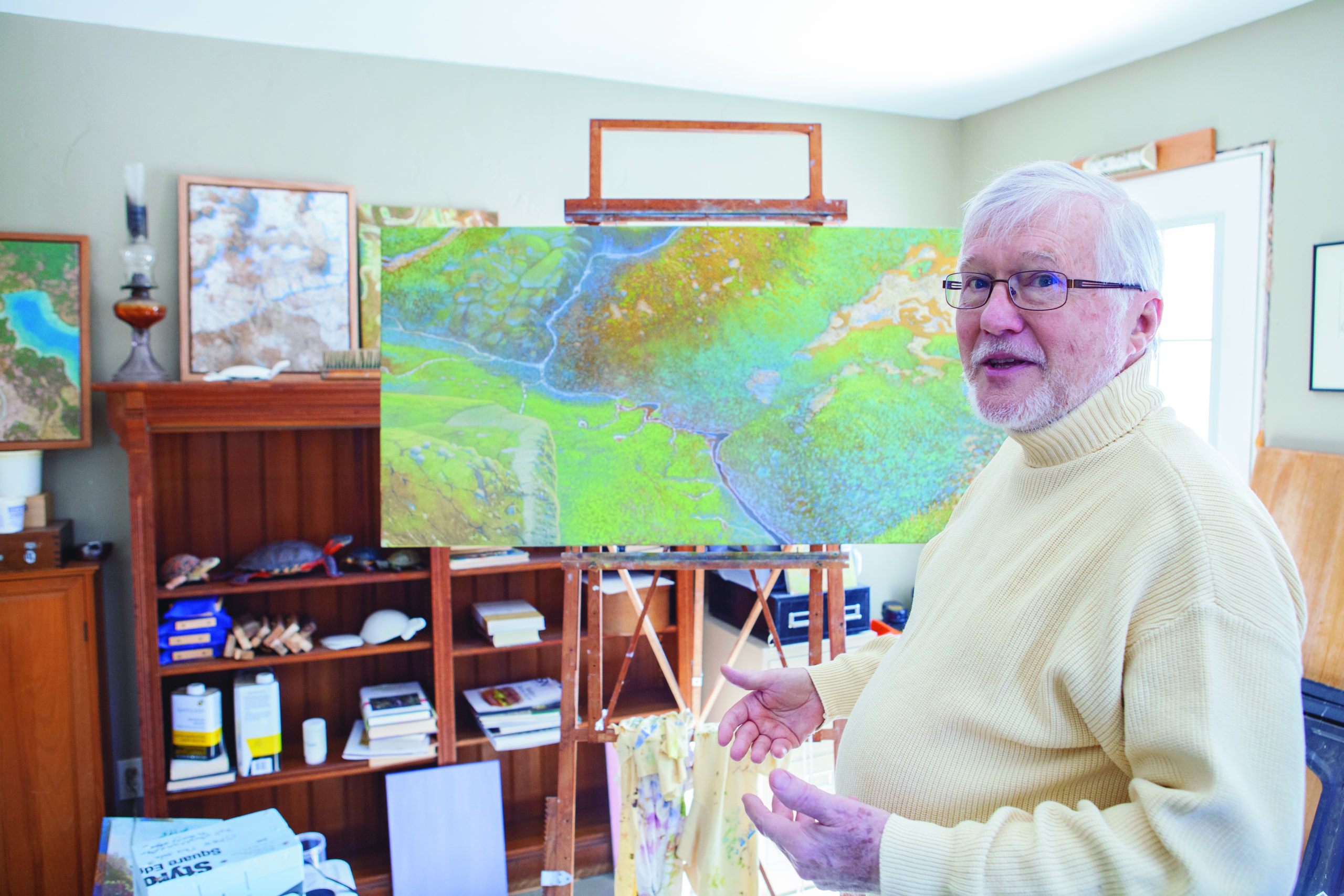
Hoyle and one of his marbelized
landscape paintings.
Hoyle served as artist in residence at the Climate Change Institute in Orono in 2008. While there, he created a Gary Larsen-esque cartoon series to help explain global warming to young people. In the story, kids find a talking mammoth in a gravel pit and watch as it struggles to adjust to current climate conditions. At the end of the story, the kids shave the creature.
Hoyle has also painted “dinosaur fantasies” over the years, humorous takes on how various species of ancient reptiles might come in handy today. He continues to create museum displays, including remarkable life-like turtles, one of which will be in “Focus on Nature XV: Natural and Cultural History Illustration,” opening in July at the New York State Museum in Albany.
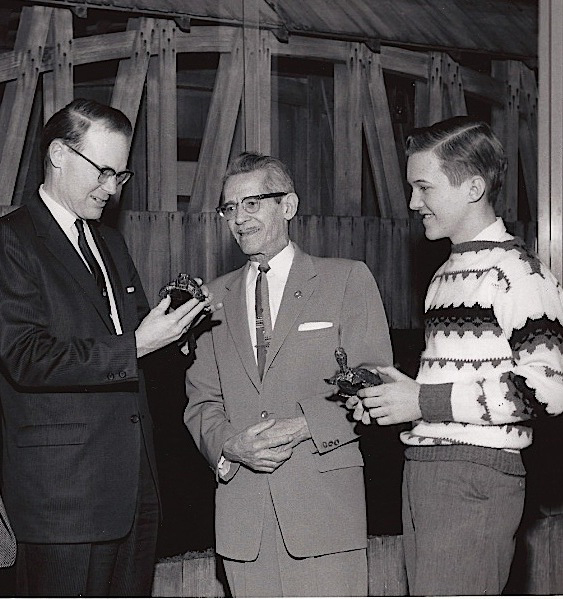
Hoyle at age 15 in 1960 presents two of his sculpted turtles to then-Governor John Reed, left, and museum curator Klir Beck for the Maine State Museum. Beck had seen Hoyle’s work and asked him to sculpt the turtles.
While officially retired, the Hoyles are busy. Last year Jeanne became executive director of the Swan’s Island Educational Society, which encompasses the library and historical collections. They spend time with family.
Hoyle spends most of his time painting. A watercolorist like his father, he began to work in oils with guidance from his mentor, Scherer. Some of the work appears in the acclaimed “Made in Maine” exhibit at the Maine State Museum.
In recent years, Hoyle has developed a marbleizing technique whereby he floats colors on turpentine and “picks them up” on canvas to create stunning vistas that resemble aerial landscapes. He is showing paintings in Rockland this summer with Jordan Chalfant, a natural history artist he mentored at College of the Atlantic.
Thanks to his neighbor, Hoyle has also become an engaged writer. Rainford has been helping him with a book that recounts digging up a mammoth skeleton in Scarborough in 1992-1993. Hoyle is interweaving the mammoth story with another concerning P.T. Barnum and the elephant that inspired him to create The Greatest Show on Earth.
“We’re not just painters and writers,” Rainford says. “I see us more as creators.”
He notes that both rebuilt their island houses, approaching the task with ingenuity and imagination. Hoyle agrees. Both are problem solvers, adept at finding the right word or color to complete a poem or painting. It’s a mutual admiration society of two men devoted to family, art, and their island community.
